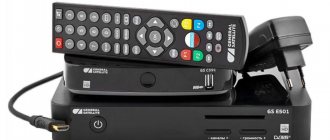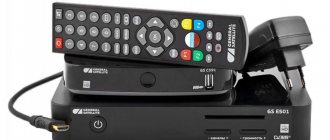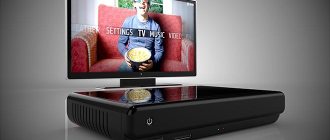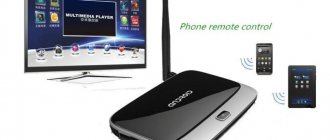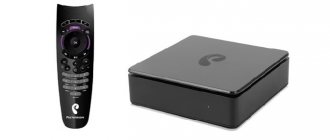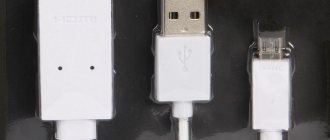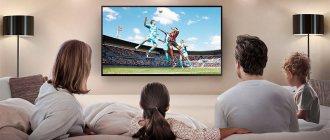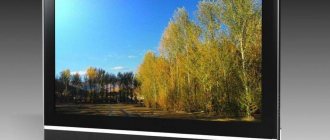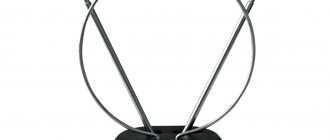Since 2009, Russia began an experiment to introduce digital television broadcasting
.
After 3 years, the first digital TV format DVB-T was replaced by a new one - DVB-T2
.
And from 2021
they plan to completely abandon analogue television.
But what should those whose TVs do not accept “digital” do?
It is not at all necessary to change the TV receiver, because you can buy an inexpensive digital TV set-top box.
This can be a simple model costing up to 1000 rubles
, or a more expensive and functional analogue -
a Smart TV set-top box
. What to choose? We will talk about this in our article.
Purpose
This device is a device capable of receiving, decoding, converting, and transmitting audio/video signals coming through a satellite dish or cable. This is separate equipment that connects to the TV.
Most people confuse the concepts of “tuner” and “receiver”. The similarity lies in the common task of signal conversion. However, the receiver decodes the digital signal, converting it to analog, and the tuner is part of it, converting the signals into other formats, which allows you to watch TV shows on your PC.
Functional Features
Each receiver has its own set of functions. Standard processes are:
- reception of television signals of various definitions (SD-TV, HD-TV, UHD-TV, 3D-TV);
- the ability to view Internet content via Smart TV;
- advanced sound settings;
- built-in media player.
More and more models support additional functions:
- play music and video from USB drives;
- recording television broadcast, pausing it at a selected moment;
- the possibility of delayed viewing (if, say, your favorite Brazilian series is on TV, but you don’t have enough time to watch it).
Digital receivers run on operating systems. As a result, their software is unlikely to become outdated if it is updated at every opportunity.
A large number of models support access to the Internet and IPTV via cable or Wi-Fi. Some have a built-in hard drive that allows you to store music and movies directly on the device.
But not all TVs need an additional device. Modern manufacturers produce models with a built-in tuner and receiver, where you just insert a smart card from a provider that provides cable TV broadcasting services. For older TVs, it is recommended to purchase a receiver.
Types of receivers according to broadcast standards
According to broadcasting standards, digital television is divided into 3 types: terrestrial, cable and satellite. Moreover, each type has one or more standards.
Terrestrial television
Terrestrial television has a unified standard DVB-T2, in which a television tower transmits a signal to a common or personal antenna, and from there, in turn, to the receiver. Terrestrial TV has no disadvantages, with the exception of a weak signal in densely built-up areas of the city, as well as in areas remote from television towers.
Today there are 2 free packages of digital channels available without a subscription fee - RTRS-1 and RTRS-2. In total they include 20 channels.
Satellite television
Satellite television is available anywhere in the world, because it is designed for a larger number of viewers - just install a satellite dish on the facade of the house and connect a receiver to it.
There are several types of satellite receivers:
- universal (can “catch” many channels, both open and encrypted, accessible with a special card);
- receivers working with certain providers;
- full-fledged multimedia centers.
The very first satellite broadcasting standard, DVB-S, was released in 1995. DVB-S2 is its improved version, supporting HD resolution and capable of transmitting more information, as well as saving on payments for digital services. For these reasons, more and more modern equipment is adapted for DVB-S2.
Finally, the third version - DVB-S2X - differs from its predecessors in a large number of types of encoding and modulation, compatibility with new generation services, and other additional functions. Its essence is to increase the efficiency of signal transmission by 20-50%.
However, satellite TV also has disadvantages. Among them are the high cost of a satellite dish and the reaction to bad weather.
Cable TV
At the moment, the most common cable broadcasting standard is DVB-C, less commonly DVB-C2. The latter is distinguished by a wide range of signal reception and a large number of available programs. Broadcasting the image via cable eliminates its distortion. The signal is transmitted via optical fiber.
Unlike a satellite dish, the cable is not affected by weather conditions. The only drawback is its low prevalence (currently cable TV is available only in large cities).
Different standards provide paid and free access to a different number of channels. So that viewers are not limited to terrestrial TV, some developers produce hybrid receivers that support several broadcast standards at once.
Standalone amplifiers
An amplifier is simply a device that takes a weak signal and amplifies it or creates a larger copy of it and then outputs it. This is necessary because without an amplified signal, you won't get enough power to drive your speakers.
But when you ask the question about amplifiers and receivers, you're not just asking whether you should buy an amplifier or receiver, because you'll need more than just an amplifier to make your setup work.
When you use a standalone amplifier, it is not actually standalone. You will need a preamp/processor, the amp itself, and speakers to make the system work. So the question about amplifiers and receivers is really different from receivers.
Choosing a receiver may seem like an easy task, in fact there are several more factors that you should consider before making your final choice!
Types of equipment
TV receivers are divided according to different criteria. In addition to the form factor and broadcasting standard, the type of connector and the price of the device play an important role.
By price range
The price depends largely on the functionality and number of supported broadcasting standards.
Receivers are classified according to two criteria:
- Budget devices, the price of which varies from 600 to 1000 rubles. Basically, they are intended only for watching TV; broadcast recording and the ability to watch interactive television are excluded.
- More expensive models (from 1 to 10 thousand rubles) have a USB connector, additional sound outputs and the ability to access the Internet via Wi-Fi or cable.
By connection type
Each receiver has connectors of different formats. You should check the availability of connectors on your TV and their types before purchasing a receiver. New generation products have an HDMI connector, while older TVs only have SCART and RCA formats.
At least one type of connector must be present:
- RCA is a standard connector for a tulip cable in three colors: yellow (for video), white and red (for both audio channels).
- SCART - you can connect other devices through it.
- HDMI - you can use it to watch high-definition television.
Additional parts for connecting digital TV
To organize cable television, you need to agree with the provider and get a smart card. For the satellite receiver, you need to additionally buy a parabolic dish + cable for it. To watch terrestrial TV channels, a UHF antenna and an additional cable are enough.
Antenna cable selection
To receive a signal, you need to connect the antenna to the set-top box with a coaxial cable.
When choosing a coaxial cable for digital TV, there are several important factors to consider:
- Outer shell
. It is mainly made from PVC and polyethylene, which is resistant to ultraviolet rays. If PVC is suitable for indoor use, then polyethylene cable is suitable as an external laying. - Route length for cable channel
. The signal power depends on it, which is affected by the resistance of the conductor material. If a long route is required (more than 10 meters), it is recommended to use a cable with a copper core instead of a steel core. - Signal strength
. Its higher level is observed in cable and terrestrial television broadcasting standards. But it is better to choose a copper cable for a satellite dish. - Thickness and material of the central core
. To reduce signal power losses, try to choose a cable with the thickest central core. The advantage of steel wires is their strength, but the signal is better transmitted through copper wires. - Cable thickness
. Typically, the power of the feeder affects the number of shielding layers, the reliability of the insulating material, and the thickness of the core. However, there are also thin cords of high quality.
Carrying out settings
When you connect for the first time, the digital tuner will automatically perform the initial setup and offer to search for channels. But in order for the TV receiver’s program to appear on the screen, you need to select the display source, most often this is done by pressing the “ Source ” button on the TV remote control.
Auto search and manual search
To search, you first need to set your country so that the device starts searching in the frequencies of the desired country and then for some time the receiver will search in the desired frequencies and display a list of available programs .
If your set-top box software cannot determine the best search settings, you will need to do this manually. Here you need to select the frequencies at which the search will be performed. It’s better to find out in advance on what frequencies you can find the required programs, so as not to sit for several hours searching for channels.
Checking the signal level
The check is needed to find out how correctly the search was carried out. In order to find out the signal quality of the desired channel, you need to find the button labeled “ Info ” on the remote control and press it. The signal level will be displayed on the screen ; if it is 60% or higher, then the setting was carried out correctly. If the indicator is lower, then you should conduct a manual search or think about buying a more powerful antenna. Also, perhaps your antenna is not directed in the direction of signal transmission, then you should try changing its direction.
Instructions for connecting a digital set-top box to a TV
- Connect the set-top box to the TV using a cable (depending on the connector);
- Connect to the set-top box a signal source (antenna, cable), for which a special input is provided. To connect via an RCA cable, insert the black jack into the analog output, and the colored ones into the video and audio inputs, respectively. Before doing this, you must turn off the power supply to the receiver and TV. A SCART cable is similar to an RCA cable, with one difference - a wide jack and connector.
- Turn on the equipment and start setting up channels.
To watch IPTV, you need a Wi-Fi adapter connected via the LAN connector. Satellite receivers have additional CAM modules (cards) that allow you to watch more channels than those offered by over-the-air packages.
The process of connecting the receiver is clearly shown in the video:
Tips for choosing a receiver
You should consider not only the price, but also your individual needs when choosing a TV set-top box. Models for 1000-2000 rubles. suitable for use in the country if you only need TV channels (some support viewing multimedia from USB). But for an apartment or country house, they buy multifunctional devices that make it possible to watch movies and IPTV, communicate on social networks and play games. Their price ranges from 8,000 rubles.
It is optimal to buy a 4-core model of Smart TV set-top box with built-in memory of 2 GB and the ability to install an additional memory card.
It is important to know, first of all, about the capabilities and parameters of a particular receiver, a convenient method for setting it up, in order to choose the appropriate option for purchase. You shouldn't focus on price. Expensive equipment may have additional functions that are not needed in a particular case.
How useful was the article to you?
Receivers and amplifiers (separately)
A more convenient and complete package is the receiver since it has more features than the amplifier and all the other components are already built in, right? Well, in some cases this is true, there are times when an amplifier may be the best choice for you.
If you're just looking to set up a home theater system and want to connect your TV, speakers, consoles, and more in one place, then a receiver is probably the right choice. But if you're an avid audiophile or just want to use your rig for music, then you'll probably want your music to sound as good as possible, in which case an amplifier may be better.
I'd say that about 95% of people will only need an A/V receiver for the reasons we explored earlier in our article on pre-outputs on receivers. Standalone amplifiers are usually only needed for more complex audio systems. If you're not sure what type of receiver to buy, check out my recommended receivers page! I've reviewed several different high-quality receivers at different price points.
